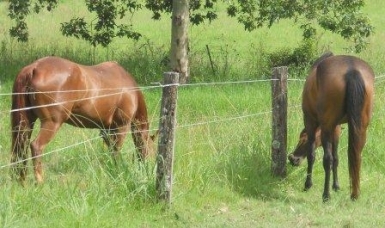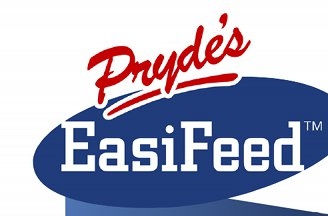Horsezone News
Don't Let Your Horse get a 'Bighead'
 by Dr Nerida Richards - Equilize Horse Nutrition Pty Ltd
by Dr Nerida Richards - Equilize Horse Nutrition Pty Ltd
Bighead is a disease resulting from a long term calcium deficiency in the diet. Bighead has severe effects on your horse, making movement painful and lameness a constant issue. Luckily though, it is a condition that is easily avoided by carefully balancing your horse’s diet.
What is Bighead?
Bighead, correctly known as nutritional secondary hyperparathyroidism is a severe calcium deficiency resulting from a horse not absorbing enough calcium from its diet. During these periods of calcium deficiency the horse’s body must adapt to maintain blood calcium levels within a normal range. To do this, parathyroid hormone levels are increased, which in turn increases the release of calcium (and phosphorus) from bone, stimulates the increased reabsorption of calcium from the kidneys and through the production of active vitamin D, stimulates increased absorption of calcium (and phosphorus) from the gastrointestinal tract to keep blood calcium levels ‘normal’.
When this state of calcium deficiency occurs for prolonged periods of time horses pull so much calcium and phosphorus from their bones that their bones become fibrous and weak.
What are the symptoms?
As its name suggests, Bighead results in the horse’s facial bones becoming fibrous and swelling to give the horse a ‘bighead’ appearance. This facial swelling appears most commonly in young horses whose facial bones haven’t fully formed and hardened, though it is possible for it to occur in mature horses as well.
Because nutritional secondary hyperparathyroidism affects a horse’s entire skeleton it will also result in shifting lameness and generally sore bones and joints. In severe case horses will be reluctant to move or may move with a ‘hopping rabbit’ gait.
Affected horses also tend to lose weight even though they have access to ample feed and get a scruffy, rough coat. Because of the swelling that occurs in the bones, the upper airways can also become obstructed resulting in noisy breathing during exercise and it is also possible for teeth to fall out.
What causes Bighead?
Bighead is literally a severe and long term calcium deficiency. There are two major causes of bighead in horses. These are:
- Unbalanced dietary calcium to phosphorus ratio – diets that contain more phosphorus than calcium will cause bighead. Phosphorus is able to block the absorption of calcium eventually leading to a severe calcium deficiency. Diets that contain large amounts of high phosphorus ingredients like wheat bran and pollard, rice bran, copra and cereal grains have high levels of phosphorus and have the potential to cause an unbalanced calcium to phosphorus ratio. Some pastures also contain more phosphorus than calcium and have the potential to cause bighead via excess dietary phosphorus.
- Grazing high oxalate pasture - sub-tropical pastures like kikuyu, buffel grass, setaria, green panic, pangola grass, guinea grass, purple pigeon grass, para grass and signal grass contain a compound known as oxalate. The oxalate in the grass binds most of the calcium available in the pasture making it unavailable for absorption when the horse eats it. So even though these grasses may contain plenty of calcium, horses cannot absorb it, so over time they will develop a severe calcium deficiency. The more oxalate the pasture contains, the more rapidly a horse will develop bighead. Setaria, and specifically Kuzungula Setaria is the most dangerous high oxalate grass for horses, with severe bighead appearing in horses grazed on this grass species within one to 3 months.
Avoiding bighead
Fortunately, bighead is a disease that is easily avoided given the correct nutrition. The strategy to avoid bighead depends on its cause.
If the disease is occurring because of an unbalanced calcium to phosphorus ratio, adding additional calcium to the diet to balance the calcium to phosphorus ratio will make sure you avoid this problem. Calcium can be added to a diet by feeding calcium supplements like limestone or high calcium forages like lucerne and clover. Dolomite is best avoided as a calcium supplement as its calcium bioavailability (the amount of calcium the horse can actually absorb) is low.
Enough calcium needs to be added to the diet to keep the calcium to phosphorus ratio above 1 part calcium to 1 part phosphorus for all horses. For young horses, the ideal calcium to phosphorus ratio range is 1: 1 to 3: 1. For mature horses the ideal range is 1: 1 to 6: 1.
As a guide, for each kg of high phosphorus meal (including bran, pollard and copra) fed in a diet you should also feed 30 grams of limestone or 1.5 kg of lucerne or clover hay. For each kilogram of cereal grain added to a diet, 10 grams of limestone or 0.5 kg of lucerne or clover hay should also be fed in the diet.
If high oxalate grasses pose a threat to your horse, you must feed enough calcium in the diet to keep the calcium to oxalate ratio above 0.5 parts calcium to 1 part oxalate. The biggest difference between bighead caused by high oxalate pastures and bighead caused by an unbalanced calcium to phosphorus ratio is that when adding calcium to the diet of horses on high oxalate pastures, phosphorus must also be added. When a horse’s parathyroid hormone levels are raised the reabsorption of phosphorus from the horse’s proximal renal tubule is blocked, resulting in a net loss of phosphorus from the body which eventually will lead to a long term phosphorus deficiency. Because of this, phosphorus intake must also be increased for horses grazing high oxalate pastures.
To correct the calcium to oxalate ratio of a horse’s diet, a 2 parts dicalcium phosphate to 1 part limestone (calcium carbonate) mixture needs to be added to the diet. Enough must be fed to keep the calcium to oxalate ratio at or above 0.5 parts calcium to 1 part oxalate. Of course you must also make sure the calcium to phosphorus ratio remains balanced.
For a horse grazing high oxalate pastures with no supplementary feed, 12 grams of limestone and 24 grams of grams of dicalcium phosphate (DCP) need to be added to the diet daily per 100 kg of bodyweight. Alternatively a lick containing a week’s worth of limestone and DCP can be made with molasses and put out once weekly. If your horses are grazing Setaria pastures, these amounts need to be increased to 16 grams of limestone and 32 grams of DCP per 100 kg bodyweight per day. Adding 2 grams of salt and 1 gram of magnesium oxide to the mixture per 100 kg of bodyweight may help to improve calcium absorption.
If the pasture is Kazungula Setaria, which contains the most oxalate of any of the pasture grasses mentioned, I recommend you have your diet professionally balanced, as it is really not possible to feed enough limestone and DCP to counteract the massive quantities of oxalate in this grass species. The management approach for horses on this type of pasture needs to include calcium and phosphorus supplementation with pasture intake restriction and the feeding of other high calcium forages.
Horses receiving supplementary feed or high calcium lucerne or clover hay or horses with restricted access to pasture will need less than these amounts of limestone and DCP, but the exact amount they will need depends what you are feeding and the type of pasture they are grazing.
Recovery from Bighead
If your horse is suffering bighead, the treatment plan you follow really depends on the cause of the disease. If the disease has been caused by an unbalanced calcium to phosphorus ratio, enough limestone and lucerne or clover hay should be added to the diet to increase the calcium to phosphorus ratio to 4 parts calcium to one part phosphorus until any symptoms have resolved. This will generally take 6 to 12 months. Once your horse no longer has any symptoms of the disease and has been on this high calcium diet for at least 6 months, the calcium to phosphorus ratio can be readjusted back to 2 parts calcium to 1 part phosphorus. Dicalcium phosphate should not be used as a calcium supplement under these circumstances.
If Bighead in your horse is due to grazing high oxalate pastures the following action should be taken:
- Where possible, remove your horse from the high oxalate pasture and provide it with free access to a low oxalate grass hay (for example Rhodes Grass Hay or any type of temperate grass hay).
- Feed 0.5 kg/100 kg of bodyweight of lucerne or clover hay per day OR feed free choice low oxalate hay with 6 grams of limestone and 12 grams of DCP per 100 kg bodyweight.
- 2 grams of sodium chloride and 1 gram of magnesium oxide per 100 kg bodyweight should also be added to the diet to help improve calcium absorption.
This feeding program and high calcium intake should again be maintained until clinical symptoms have resolved which will take 6 to 12 months. Once symptoms have resolved, the horse can be returned to pasture with adequate calcium supplementation as described above.
All horses recovering from Bighead should also receive a balanced vitamin and mineral supplement. It may be of benefit to use one that does contain some vitamin D.
 Balancing diets for horses grazing high oxalate pastures can be tricky. To make sure you get it right, Pryde’s offer a free diet analysis service to help you keep your horses diet balanced so your horse is not at risk of Bighead Disease. To request a free diet analysis, go to the Pryde’s Diet Analysis Request Form on their website: http://prydes.com.au/index.php?option=com_jforms&view=form&id=2&Itemid=60. Or, to discuss you needs call Pryde’s on 1300 732 267 or email info@prydes.com.au
Balancing diets for horses grazing high oxalate pastures can be tricky. To make sure you get it right, Pryde’s offer a free diet analysis service to help you keep your horses diet balanced so your horse is not at risk of Bighead Disease. To request a free diet analysis, go to the Pryde’s Diet Analysis Request Form on their website: http://prydes.com.au/index.php?option=com_jforms&view=form&id=2&Itemid=60. Or, to discuss you needs call Pryde’s on 1300 732 267 or email info@prydes.com.au
News Search
Categories
- General
- Event Results
- Stallionzone
- Sponsored Shows
- Clubs
- Health
- Feature Horses
- Competitions
- Five Minutes With Horsezone
- Young Riders
- Reviews
- Training and Clinics
- Postcards from the saddle
- 2014 Equitana by HORSE FIRST
- 2013 Equitana
- 2012 Equitana
- 2012 London
- 2011 Equitana
- 2011 Queensland Floods
- 2010 WEG
